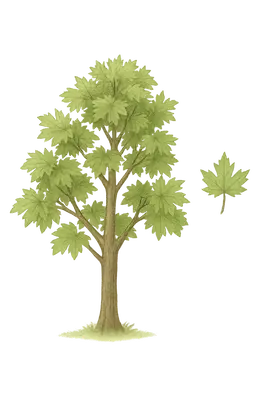Maple (Tree)
Description
Maple trees (Acer species) are renowned for their distinctive lobed leaves and vibrant autumn colors. With over 125 species, maples are native to Europe, Asia, North Africa, and North America. Common species include the sugar maple (Acer saccharum), red maple (Acer rubrum), and silver maple (Acer saccharinum). These deciduous trees are often planted as ornamental shade trees in urban and suburban areas.

Allergy Symptoms
Exposure to maple pollen can cause:
- Nasal issues: Sneezing, runny or congested nose.
- Eye discomfort: Itchy, watery, and red eyes.
- Respiratory problems: Coughing, wheezing, and potential worsening of asthma symptoms.
- Throat irritation: Itchy or sore throat.
Individuals with maple pollen allergies may also experience heightened sensitivity during high pollen count days.
Typical Pollination Period
Maple trees have an extended pollination period due to the diversity of species:
- Early pollinators: Some species begin releasing pollen in late winter (as early as January).
- Peak season: Most maple trees pollinate in early spring, with March and April being the most intense months.
- Late pollinators: Certain species continue to release pollen into early summer.
This staggered pollination can result in prolonged exposure for allergy sufferers.
Geographic Distribution
Maple trees are widely distributed across various regions:
- North America: Native species are prevalent throughout the United States and Canada, commonly found in forests, along roadsides, and in urban landscapes.
- Europe and Asia: Various species are native to Europe and parts of Asia, often cultivated for their aesthetic appeal.
- Introduced regions: Maples have been planted in other parts of the world for ornamental purposes, adapting well to diverse climates.
Tips for Reducing Exposure and Managing Allergies
- Stay informed: Regularly check local pollen forecasts to anticipate high pollen days.
- Minimize outdoor exposure: Limit outdoor activities during peak pollen times, especially in the morning when levels are highest.
- Create a pollen-free environment: Keep windows closed during pollen season and use air conditioning with clean filters to reduce indoor pollen.
- Personal care: After spending time outdoors, shower and change clothes to remove pollen from your body and hair.
- Medication management: Utilize antihistamines, decongestants, or nasal sprays as directed by a healthcare provider to alleviate symptoms.
- Seek professional advice: If symptoms persist or significantly impact daily life, consult an allergist for personalized treatment options, including potential immunotherapy.